In the rapidly evolving architecture of artificial intelligence, we’ve moved beyond treating AI as a faceless tool. Instead, we now focus on crafting the AI persona—a distinct, recognizable character that dictates how the system communicates and engages with users. This is the “who” behind the algorithm, the personality that breathes life into the interaction.
The power of an AI’s tone cannot be overstated; it is the primary driver of user perception, shaping everything from trust and credibility to overall satisfaction. While many tones exist—friendly, humorous, professional—the instructive tone is emerging as a critical component for AI designed to empower users. This is not merely about providing information. An instructive tone is a deliberate, methodical approach to communication that aims to guide, educate, and enable. It transforms the AI from a simple information provider into a capable, digital mentor, ready to foster understanding and facilitate meaningful action.
Deconstructing the Instructive Tone: Core Principles and Characteristics

An effective instructive tone is not accidental; it is engineered from a set of core principles. To build an AI persona that successfully guides and educates, one must integrate the following characteristics into its communication framework. Each principle serves as a pillar, supporting the persona’s primary goal of fostering user comprehension and capability.
- Clarity and Conciseness: The foundational principle is the elimination of ambiguity. An instructive AI must communicate using straightforward language, systematically avoiding technical jargon, acronyms, and convoluted sentence structures that could confuse the user. Information should be presented in logical, digestible units. For example, instead of saying, “It’s imperative to configure the application’s API endpoints prior to data instantiation,” the AI should state, “First, let’s set up the correct data connections. To begin, open the settings menu and select ‘Data Sources.'” The objective is efficient knowledge transfer, not a demonstration of the AI’s expansive vocabulary.
- Authority and Credibility: Users must trust the information being provided. The AI persona must project authority not through arrogance, but through confident and factually accurate language. This is achieved by training the AI on verified, high-quality data and programming it to present information with conviction. Where appropriate, citing sources or referencing established standards can bolster its credibility. For instance, an AI guiding a user through a financial decision might say, “Based on established financial planning principles, a diversified portfolio is recommended to mitigate risk.”
- Action-Oriented Language: Instruction implies action. The AI’s language must be dynamic, employing strong verbs and clear calls-to-action that leave no doubt about the necessary next steps. This transitions the user from a passive recipient of information to an active participant. Phrases like, “Now, click the ‘Submit’ button,” “The next step is to copy the security key,” or “To see the results, select ‘Generate Report'” are direct and effective.
- Patience and Adaptability: A key differentiator for an instructive AI is its capacity for patience—a quality humans often lack. The AI must be prepared to rephrase explanations, offer alternative examples, or break down complex steps into more granular micro-steps if the user struggles. It should be able to detect signals of misunderstanding from user input (or lack thereof) and adapt its instructional strategy accordingly, asking, “Would you like me to explain that in a different way?” or “Let’s try a simpler approach.”
- Encouragement and Positive Reinforcement: Learning and execution can be challenging. An instructive persona should be programmed to provide positive reinforcement to maintain user motivation. Simple, well-placed affirmations like, “That’s correct,” “You’ve successfully completed the first stage,” or “Great job, we’re making good progress” can significantly improve the user experience and encourage persistence through multi-step processes.
The Application of an Instructive Tone: Where and Why It Matters Most

The utility of an instructive AI persona is not universal but is exceptionally high-value in specific domains where clear guidance is paramount to success and safety.
- Educational and E-Learning Platforms: This is the most natural application. AI tutors can provide personalized, step-by-step guidance in subjects ranging from mathematics to language learning. The instructive tone ensures students are not just given answers but are taught the methodology to arrive at the solution themselves, reinforcing learning pathways.
- Complex Software and Technical Support: During user onboarding for sophisticated software (e.g., CRM systems, data analytics tools), an instructive AI can be invaluable. It can walk a new user through the interface, explain core functionalities, and reduce the initial learning curve. This minimizes reliance on human support teams and empowers users to become proficient more quickly.
- Healthcare and Wellness Applications: The need for precision in healthcare is critical. An AI health assistant with an instructive tone can clearly articulate medication schedules, demonstrate physical therapy exercises through connected media, or explain dietary requirements. This clarity is vital for patient adherence and safety.
- Financial Services: Understanding financial products like mortgages, investments, or insurance policies can be daunting. An AI advisor using an instructive tone can break down complex terms and conditions, explain risk versus reward, and guide users through application processes, promoting financial literacy and confident decision-making.
- “Do-It-Yourself” (DIY) and Skill-Building Applications: Whether teaching a user to assemble furniture, perform a basic car repair, or execute a new cooking technique, an instructive AI provides a safe and effective learning environment. It can present steps sequentially and wait for user confirmation before proceeding, ensuring the process is followed correctly.
How to Build an AI Persona with an Instructive Tone: A Step-by-Step Guide
Developing an AI persona with a convincing instructive tone requires a methodical approach that combines persona definition with technical implementation.
- Defining the Persona’s Identity and Expertise: The process begins with establishing the “why.” What specific knowledge will this AI impart? Its purpose dictates its identity. You must then construct a logical background that lends the persona credibility. For example, an AI designed to teach coding might be given the persona of “a former senior software architect at a major tech firm.” This provides a framework for its vocabulary and interaction style.
- Crafting the Voice and Language: This is where the persona takes shape. A detailed style guide must be developed, outlining acceptable vocabulary, sentence complexity, and the precise level of formality. Crucially, this guide should include a library of instructive phrases (“The first step is to…,” “To do this, you will need…,” “Let’s break this down further…”) to ensure consistency in its teaching methodology.
- Structuring the Interaction Flow: An instructive AI must present information in a logical, progressive sequence. The interaction design should map out these flows, ensuring that foundational concepts are introduced before more advanced ones. This structure must also include checkpoints for understanding—points where the AI explicitly asks the user a question (“Does that make sense?”) or gives them a small task to verify comprehension before moving to the next topic.
- Data Training and Fine-Tuning: The performance of the AI model is contingent upon the data it is trained on. To cultivate an instructive tone, the model must be trained on high-quality, curated datasets that exemplify clear, accurate, and educational communication. This could include technical manuals, educational transcripts, and other instructional materials. The process is iterative; after initial training, the persona must be tested extensively, with its responses continually refined based on user interactions and feedback to correct errors and improve clarity.
The Measurable Benefits of a Well-Crafted Instructive AI Persona

Implementing an instructive AI persona is not merely an aesthetic choice; it delivers quantifiable returns and tangible improvements to the user experience.
- Increased User Comprehension and Retention: By presenting information clearly and logically, an instructive AI ensures users don’t just hear the information—they understand it. The step-by-step methodology enhances knowledge retention far more effectively than dense blocks of text.
- Reduced User Error and Frustration: Proactive and clear guidance is the most effective way to prevent user error. By leading the user through a process, the AI minimizes the chances of mistakes, which in turn reduces user frustration and abandonment of the task.
- Enhanced User Autonomy and Empowerment: The goal of instruction is to build capability. An effective instructive AI teaches users how to perform tasks independently. This fosters a sense of empowerment and self-sufficiency, turning novice users into proficient ones.
- Improved Trust and Credibility in the AI System: When an AI consistently provides clear, correct, and helpful guidance, users begin to trust it as a reliable resource. This credibility is essential for long-term user engagement and adoption of the technology.
- Higher User Engagement and Task Completion Rates: Users are far more likely to remain engaged and see a process through to completion when they feel supported and confident. The guiding hand of an instructive AI provides this support structure, leading directly to higher task completion rates and better overall outcomes.
The Future of Instructive AI: Trends and Predictions
The development of instructive AI is still in its relatively early stages. The coming years will see significant advancements that make these personas even more effective and integrated into our digital lives.
- Hyper-Personalization: The next frontier is AI that adapts its instructive tone and teaching style to the individual. By analyzing a user’s interaction history, pace of learning, and error patterns, the AI will be able to determine if the user learns best from visual aids, concise text, or detailed analogies, and adjust its approach in real time.
- The Rise of Proactive Instruction: Future AI will move from reactive to proactive guidance. Instead of waiting for a user to ask for help, the AI will anticipate potential points of confusion based on the user’s behavior. For instance, if a user hesitates on a certain field in a form for an extended period, the AI might proactively intervene with a pop-up saying, “It looks like you might have a question about this section. This field requires…”
- The Integration of Multimodal Instruction: Instruction is often most effective when it leverages multiple formats. The future of instructive AI lies in its ability to seamlessly combine its spoken or written words with other media. An AI could guide a user by saying, “Watch this short video that demonstrates the technique,” or “I’ve highlighted the button you need to press on your screen.”
- The Ethical Considerations of Instructive AI: As these systems become more persuasive and integrated into critical decision-making processes (like finance and healthcare), the ethical considerations will grow. Ensuring transparency in how the AI operates, preventing manipulative language, and programming it with a core of responsible, unbiased guidance will be paramount for developers and regulators alike.
Conclusion: The Instructive AI Persona as a Cornerstone of User-Centric Design
We have deconstructed the principles of the instructive tone, examined its critical applications, and outlined the methodology for its creation. The evidence is clear: the instructive AI persona is far more than a feature. It is a fundamental component of user-centric design in an increasingly complex technological world.
The ultimate goal of much of our technology is to enhance human capability, and there is no more direct way to achieve this than through effective teaching. By moving beyond simple information retrieval and embracing the role of a digital mentor, we can build AI that doesn’t just provide answers, but fosters understanding, builds confidence, and truly empowers the user. The future of effective, responsible AI will be built on its ability to teach.







